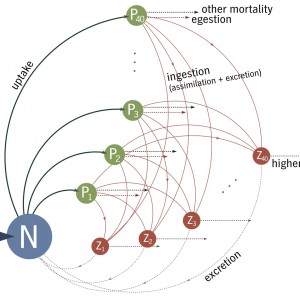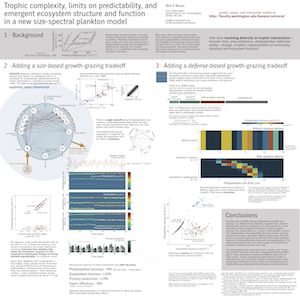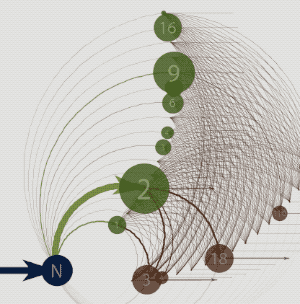 Natural plankton communities are far more diverse than even a very complicated numerical model can account for. The ASTroCAT model (Allometric/Stochastic Trophic Complexity Analysis Tool) is an experiment in systematically resolving the complexity in phytoplankton–microzooplankton trophic interactions, and exploring the effects of this complexity on ecosystem structure, function, and predictability.
Natural plankton communities are far more diverse than even a very complicated numerical model can account for. The ASTroCAT model (Allometric/Stochastic Trophic Complexity Analysis Tool) is an experiment in systematically resolving the complexity in phytoplankton–microzooplankton trophic interactions, and exploring the effects of this complexity on ecosystem structure, function, and predictability.
This paper…
Banas NS (2011) Adding complex trophic interactions to a size-spectral plankton model: Emergent diversity patterns and limits on predictability. Ecol. Modelling 222:2663–2675 (download pdf)
… lays out the story so far. One of the most provocative results is shown here (click to enlarge):
This shows the time evolution of modeled phytoplankton communities subject to (a) size-based and (b,c) increasingly selective and species-specific predation pressure by microzooplankton. Under size-based predation alone (a), this chemostat-like system settles into a stable community composition, although the timescale over which this process unfolds is surprisingly long: more than 2 years, even though all community members are microbes with individual turnover times on the order of a day. With the addition of complex, selective trophic interactions (b,c), intense intermittency develops in which species appear or disappear for weeks or years at a time with no external driver. The system isn’t chaotic; it just requires so long to reach equilibrium that it never will, in any real ocean system, before another kick from the environment sets it ringing again.
In other words: one predator-prey pair have a tendency to do this…
(N, P, Z = nutrient, phytoplankton, zooplankton)
… and if you hook together a spectrum of these oscillators, they do this …
 Here’s a poster from the Ocean Sciences Meeting, 2012, describing some next steps with a more realistic testbed and an added axis of diversity: phytoplankton defense against grazing.
Here’s a poster from the Ocean Sciences Meeting, 2012, describing some next steps with a more realistic testbed and an added axis of diversity: phytoplankton defense against grazing.


